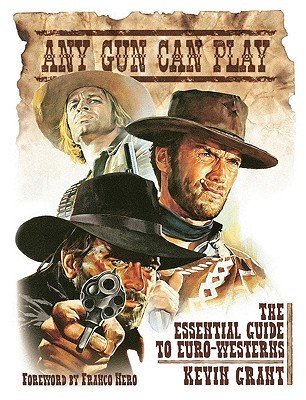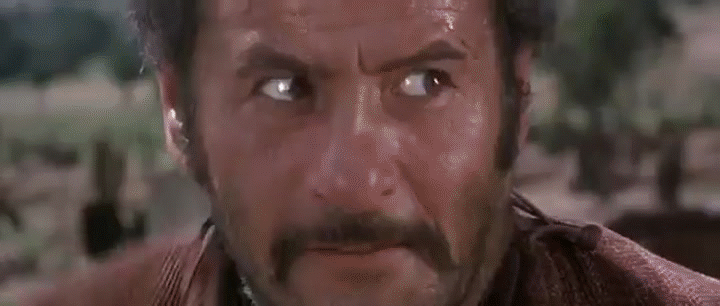Yeah. I really love that theme song. It works impeccable with the film.
That's a huge question, obviously.
One contribution were -- simply -- Mussolini and the Fascists. During WW2, there was an embargo on American films. However, when the embargo was broken, several decades of great American movies where suddenly bombarded onto Italian cinemas. So Italians got to see a whole boatload of the best American westerns in a very short timespan. The future directors who would grow up and make these Spaghetti Western movies -- like Sergio Leone, Sergio Courbucci, Sergio Solima -- all watches these movies in their youths. There was an concertration effect, basically. While in America, people watches all the western as they came out -- in Italy, they watched all the best westerns in a relatively short spann of years.
So this effect created a lot of Italian Western fans. However, while they adamantly loved the genre and its elemental trappings, they were also critical of it. There was basically a cultural difference at work that colour their perspective and assessement of it.
Contrary to popular belief, there were European Westerns looong before Sergio Leone got together with Clint Eastwood. But they all uniformally sucked (except Lemonade Joe... Lemonade Joe is fucking hysterical). Why did they suck? Because they slavishly copied the American formula. They tried to copy-paste American films but, naturally, they could beat the Americans by their own playing rules. The director of this movie, Sergio Corbucci, even made one of them, Minnesota Clay.
What Sergio Leone did -- was to make Westerns after a Italian sensibility. He didn't want to copy the American style but to create his own sub-group of Westerns. This was the 60's after all. Reforming and recreating things were in fashion. American westerns were also being remade by people like Peckinpah. Other directors picked up on this trend and followed.
So here you have a situation with a bunch of directors who grew up watching westerns -- were very knowlagable about the genre -- yet had a mission to see it changed. That a recipe for a pretty dope movement right there.
Corbucci was one of the most ardent disciples of this movement. He said that he deliberately made Django to be a very iconoclastic western. Some examples of how this is a Spaghetti Western as oppose to an Traditional American western:
* Django doesn't ride into town. American cowboys always had horses. Seeing him walk communicates the drudgery and lonesomeness of his situation. Horses signify a sense of freedom -- of being able to travel freely around the frontiers. That's not what Django is about.
* All the design and costuming is very rugged, worn and lived-in. There is a gritty -- yet also evocative -- quality to the production. In comparison, here is a picture from the 1971 John Wayne movie Big Jake (a fairly good film actually), one of the last Traditional Westerns. Notice how prim and straight-laced the clothing is. It's a more classical cowboy design, utilitarian. In Django, there is dirt and grime everywhere. People look more rugged. It gives the film and entierly different feel. There is also a greater attention to detail and ornateness to the production.

* There is also a more "European and Catholic" sensebility towards morality in Spaghetti films. Characters are cruel and sadistic, almost like animals. However, as we find out, even Django's motivations arn't pure. It's revealed that he wants to escape off with the gold. He isn't the moralistic hero that we first assume him to be. You can also see this in Eastwood's films, where he is a lot more morally ambigious.
Sure you could see ambigiously moral characters in classical Hollywood Westerns. Like, say, the really good The Naked Spurr. But in American Westerns, the entire point of the film was to "overcome" this ambiguity, make the characters wholesome again. In Eastwood's films, there is no "straightening-out" process at all to be had. And in Django, Nero's murky motives is introduced as if the film had just pulled the rug from straight under us. Suddenly he's in-league with the callous Mexicans and really onlt wants a big pot of gold, shooting up the bartenders bar and acting cold-hearted towards his love-interest. It's that Catholic doctrine of everyone being a sinner. There is moral weakness and evil within him. He even kills Federales who seem to be completely innocent. Nero only redeams himself after a whole lot of pain, being crippled, seeing his plans thwarted, and other people dying. You didn't see such harshness before.
* Another point is the focus on music. Italy has a superb music industry. They exploited that fact ruthlessly. So in Spaghetti Westerns, the soundtrack is much more integrated with the movie than it was in American films.
* Spaghetti pictures were also plain more violent and brutal than American's were. John Wayne famously refused to shoot an character in the back, even though it was just a film. Hollywood westerns had to portray a straight-laced morality for its heroes and its use of violence. The Italians went operatic with their violence just as they did with their music and production design (and pretty much everything else I suppose). They made violence a spectable. The violence became a show in-and-of-itself, rather than just something that had to be present in the story. Watch a traditional Western like Rio Bravo. It's a fantastic movie -- one of the best Westerns ever -- but it's use of violence is rather uncreative and stock at its final shootout. Stand behind some cover and shoot at the bad guys standing behind another piece of cover. The Italians made violence into a show that you could have fun with.
EDIT: * Another iconoclastic element is how this movie completely does away with tropes like Cowboys and Indians. There are none to be found in Django (just like in Eastwoods movies). Instead the enemies are more general. There is a war-like atmosphere between the gangs, it isn't just cattle rustling. The Southern gangs racism is more pointedly called out. You didn't see that in traditional Westerns.
* I'm sure there is more... but my fingers hurt...













